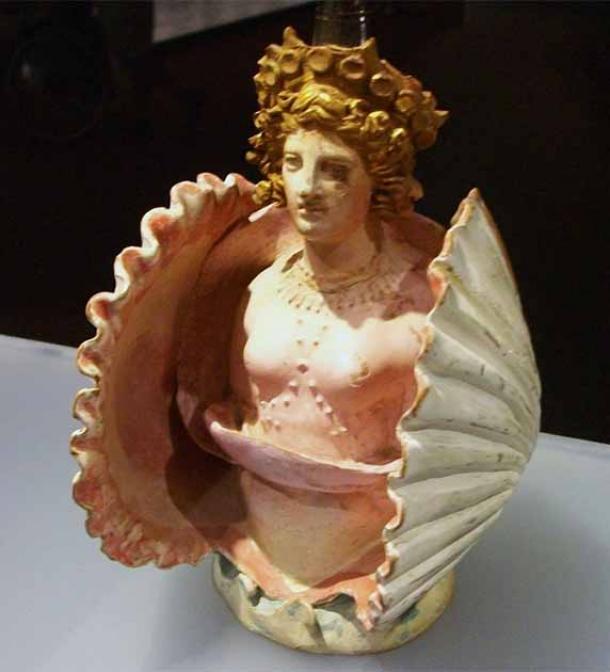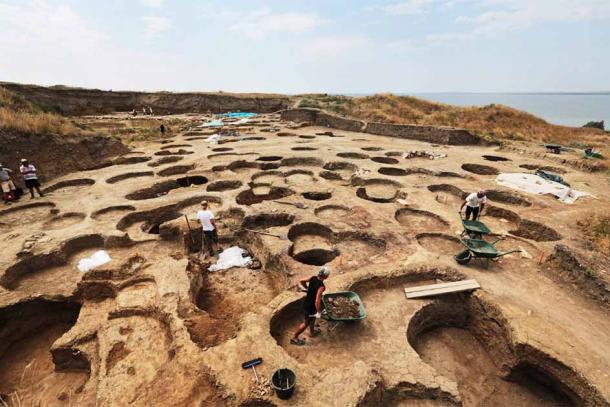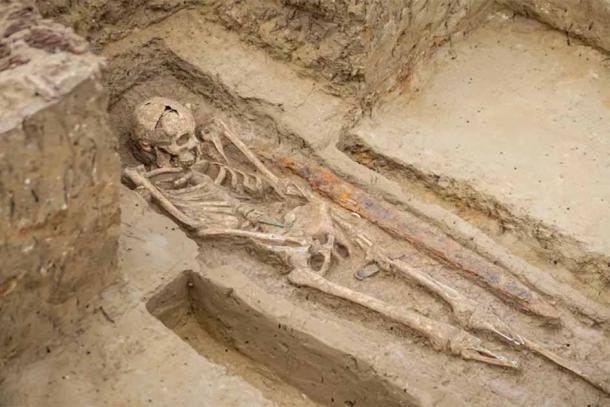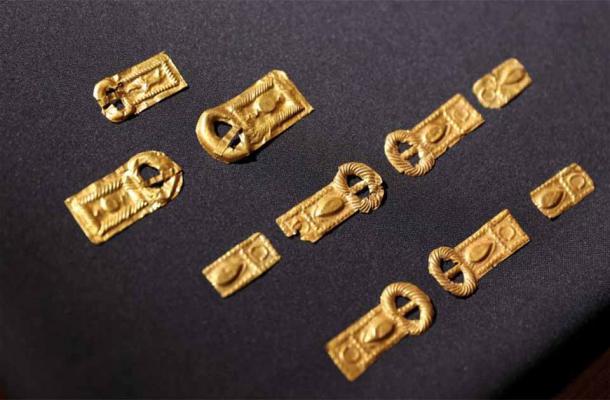
Graves of Elite Warrior and Aphrodite Cult Priestess Uncovered in Russia
Archaeologists have unearthed a 1,900-year-old burial of a priestess from an Aphrodite cult in the ancient necropolis of Phanagoria in Russia, as well as a warrior’s burial, complete with a cache of artifacts and ornate sword.
Phanagoria was established on the coast of the Taman Peninsula in southern Russia, along the Black Sea. It corresponds with the present-day boundaries of the Strait of Kerch.
Examining the Grave of the Aphrodite Priestess
The Phanagoria Archaeological Expedition, underway since 2004, has been supported by the Oleg Deripaska Volnoe Delo Foundation, Haaretz reported. The priestess’s grave, dated to the 1st century AD, was found in the summer of 2022 by archaeologists Nikolay Sudarev and Mikhail Treister. The ancient Greek goddess Aphrodite was associated with love, lust, beauty, pleasure, passion, and procreation.

The recent discoveries are not the only Aphrodite-themed objects recovered from Phanagoria. Pottery vessel in the shape of Aphrodite inside a shell; discovered in the Phanagoria cemetery, 1st quarter of 4th century BC (JoanBanjo / CC BY SA 3.0)
The grave included a fabulous silver medallion, 7 centimeters (2.75 inches) in diameter and 15 millimeters (0.9 inches) thick. This ornament displayed the goddess Aphrodite and signs of the zodiac too, although it was missing Aquarius and Libra. These medallions were generally used as brooches, pendants, or headgear accessories, and were potential indicators of astrology, the pseudoscience that posits causative relationships between the positions of celestial bodies and events on Earth.
Since the medallion was fully intact, it is a puzzle why these two signs were missing, but further investigations will probably help shed light on this matter. According to Maria Chashuk, senior research associate of the Phanagoria archaeological expedition, such medallions were characteristic of the Bosporan Kingdom as early as 2,300 years ago!
“It was found on the lower part of the woman’s chest. On the flipside, there is a brace through which one could put a cord and wear the medallion as a pendant. It looks like that was how the medallion was worn by the woman, but that question is still being studied… The images of the zodiac signs around the goddess also point to the fact that this is indeed Aphrodite Urania, as they emphasize her heavenly hypostasis,” Chashuk explained about the conclusion that this find was related to a priestess of Aphrodite’s cult.

Phanagoria is Russia's largest archaeological monument of the ancient era, located on the Taman Peninsula. In the photo: excavations of the upper city. The upper city, or Acropolis, is the site of the original settlement. (Maria Plotnikova / CC BY 4.0)
The Warrior Grave
Historians believe the sword in the warrior’s grave, which was originally from early medieval Iran, is suggestive of representation from the Phanagorian elite. The warrior was likely a member of the aristocratic military culture of the Bosporan Kingdom, an ancient Greco-Scythian state located in what is now eastern Crimea.
The Bosporan Kingdom is often recognized as the first truly Hellenistic kingdom. The recovered sword had a distinctive golden pommel on the wooden hilt, which helped trace its origins to the Iranian group of swords.
- Coin Hoard Linked to Sudden Attack on Ancient City of Phanagoria
- Ancient Fort and Stele Proclaiming Victory of Famous Persian King Found in Russia

Grave with Sassanian sword (Igor Dikin / Oleg Deripaska’s Volnoe Delo)
The presence of the Iranian sword suggests a connection with the Sassanian or Neo-Persian Empire, and the sword was likely either given as a diplomatic gift or taken as a military trophy. This corroborates historic sources that describe the Sassanid Empire’s influence in the Caucasus region, and in the Taman Peninsula, according to Alexey Voroshilov, head of the expedition team. “This is the first major discovery in Phanagoria testifying to cultural ties between the elites of Phanagoria and the Sassanid Empire,” he provided.
The sword was among other finds, like fragments of a harness, buckles, and belt tips, along with items indicative of a higher social status – glass jugs, utensils (both metal and wooden), and wooden boxes with decayed cloths, reports Heritage Daily.
- The Royal Kurgan of Kerch: The burial mound built by a king
- Southern Turkey Artifacts Dated to 7th-century Byzantine-Sassanid War

Stunning burial goods are adding to the understanding of the culture and trade relationships in ancient Phanagoria (Vitaly Timkiv / Oleg Deripaska’s Volnoe Delo)
"Probably the sword was part of diplomatic offerings from the East or was a war trophy. This, in turn, allows us to conclude that during this period, Phanagoria actively participated in political processes in the Black Sea region and in the Caucasus", according to a statement by the Oleg Deripaska Volnoe Delo Foundation.
Several types of jewelry were also found in the graves, including two rings with poorly preserved images of cornucopia and Eros with wings, two silver earrings with dove-shaped pendants (an association with Aphrodite), as well as a bronze mirror and a string with 157 beads on it.
Phanagoria, Christianity, and What Comes Next
The Greek colony of Phanagoria was founded by Teian colonists in the 6th century BC after conflicts with the Persian king Cyrus the Great. They had to flee the Asia Minor area around 543 BC, and the newly-established city took its name from one of the colonists who had fled and founded it. The city became a major trading center, and with its massive necropolis covered almost 2,300 acres!
Christianity came quite late to the region, so the finds associated with the Greek pantheon gods are not surprising. In fact, Christianity arrived as late as the 9th and 10th centuries, before which pagan rituals and traditions were followed, including Slavic paganism.
During the summer, treasure hoards were found within Phanagoria, along with other settlements in the Taman area. This suggested they had been deposited by medieval inhabitants, who were perhaps responding to conflict or threats of invasion. There were both small and large deposits, a distinction between life savings and everyday salaries. Moving forward, the archaeologists hope to be able to dig deeper into the nature of the cult worship in this larger area.
Top image: A silver medallion was discovered in the grave of an Aphrodite priestess, showing the goddess and signs of the zodiac, minus Aquarius and Libra. Source: Vitaly Timkiv/Oleg Deripaska's Volnoe Delo
By Sahir Pandey
References
Ancient Iranian Sword Unearthed in Russia. October 18, 2022. Tehran Times. Available at: https://www.tehrantimes.com/news/477732/Ancient-Iranian-sword-unearthed-in-Russia.
Excavations Uncover the Treasures of the Ancient Inhabitants of the Taman Peninsula. October 14, 2022. Heritage Daily. Available at: https://www.heritagedaily.com/2022/10/excavations-uncover-the-treasures-of-the-ancient-inhabitants-of-the-taman-peninsula/144969.
Phanagoria: Aphrodite's medallion and Iranian sword found in a Greek colony in Russia. October 19, 2022. Greek City Times. Available at: https://greekcitytimes.com/2022/10/19/phanagoria-aphrodites-medallions/.
Schuster, R. October 18, 2022. Archaeologists Find Grave of Aphrodite Priestess in Ancient Black Sea City. Haaretz. Available at: https://www.haaretz.com/archaeology/2022-10-18/ty-article-magazine/archaeologists-find-grave-of-aphrodite-priestess-in-ancient-black-sea-city/00000183-eb70-da6b-a1fb-fbf5a13f0000.
















Comments
Well, Aquarius (water) and Libra (scales) are THE TWO zodiac symbols that represent equilibrium. Perhaps their omission was symbolic of a war-torn world.
Nobody gets paid to tell the truth.